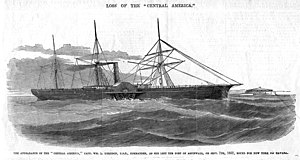SS Central America
 |
|
| History | |
|---|---|
| Name: | Central America |
| Operator: | United States Mail Steamship Company |
| Fate: | Sunk 1857 |
| General characteristics | |
| Tonnage: | 2,141 long tons (2,175 t) |
| Length: | 278 ft (85 m) |
| Beam: | 40 ft (12 m) |
| Crew: |
Captain William Lewis Herndon First Officer Charles W. van Rensselaer |
Captain William Lewis Herndon
SS Central America, known as the Ship of Gold, was a 280-foot (85 m) sidewheel steamer that operated between Central America and the eastern coast of the United States during the 1850s. She was originally named the SS George Law, after Mr. George Law of New York. The ship sank in a hurricane in September 1857, along with more than 420 passengers and crew and 30,000 pounds (14,000 kg) of gold, contributing to the Panic of 1857.
On 3 September 1857, 477 passengers and 101 crew left the Panamanian port of Colón, sailing for New York City under the command of William Lewis Herndon. The ship was heavily laden with 10 short tons (9.1 t) of gold prospected during the California Gold Rush. After a stop in Havana, the ship continued north.
On 9 September 1857, the ship was caught up in a Category 2 hurricane while off the coast of the Carolinas. By 11 September, the 105 mph (165 km/h) winds and heavy seas had shredded her sails, she was taking on water, and her boiler was threatening to go out. A leak in one of the seals between the paddle wheel shafts and the ship's sides sealed its fate, and, at noon that day, her boiler could no longer maintain fire. Steam pressure dropped, shutting down both the pumps that had been keeping the water at bay and the paddle wheels that kept her pointed into the wind as the ship settled by the stern. The passengers and crew flew the ship's flag upside down (a sign of distress in the United States) to try to signal a passing ship. No one came.
A bucket brigade was formed and her passengers and crew spent the night fighting a losing battle against the rising water. During the calm of the hurricane, attempts were made to get the boiler running again, but these all failed. The second half of the storm then struck. The ship was now on the verge of foundering. Without power, the ship was carried along with the storm, so the strong winds would not abate. The next morning, two ships were spotted, including the brig Marine. One hundred fifty-three passengers, primarily women and children, managed to make their way over in lifeboats. However, the ship remained in an area of intense winds and heavy seas that pulled the ship and most of her company away from rescue and eventually sent the ship to the bottom at 8:00 that night. As a consequence of the sinking, 425 people were killed. A Norwegian bark, Ellen, rescued an additional fifty from the waters. Another three were picked up over a week later in a lifeboat.
...
Wikipedia
